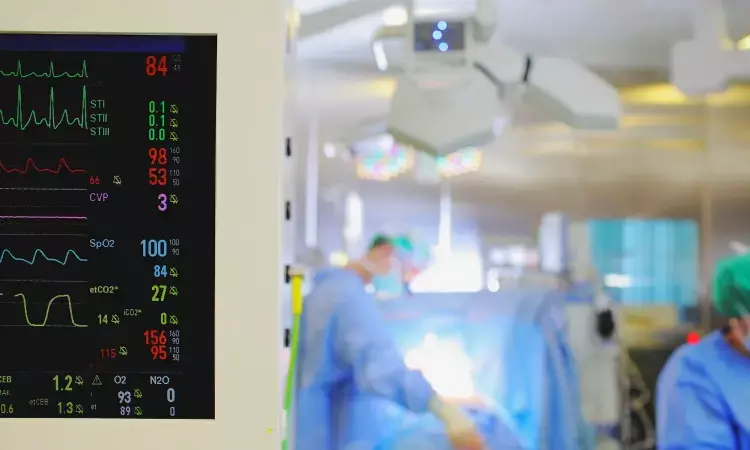- Home
- Medical news & Guidelines
- Anesthesiology
- Cardiology and CTVS
- Critical Care
- Dentistry
- Dermatology
- Diabetes and Endocrinology
- ENT
- Gastroenterology
- Medicine
- Nephrology
- Neurology
- Obstretics-Gynaecology
- Oncology
- Ophthalmology
- Orthopaedics
- Pediatrics-Neonatology
- Psychiatry
- Pulmonology
- Radiology
- Surgery
- Urology
- Laboratory Medicine
- Diet
- Nursing
- Paramedical
- Physiotherapy
- Health news
- Fact Check
- Bone Health Fact Check
- Brain Health Fact Check
- Cancer Related Fact Check
- Child Care Fact Check
- Dental and oral health fact check
- Diabetes and metabolic health fact check
- Diet and Nutrition Fact Check
- Eye and ENT Care Fact Check
- Fitness fact check
- Gut health fact check
- Heart health fact check
- Kidney health fact check
- Medical education fact check
- Men's health fact check
- Respiratory fact check
- Skin and hair care fact check
- Vaccine and Immunization fact check
- Women's health fact check
- AYUSH
- State News
- Andaman and Nicobar Islands
- Andhra Pradesh
- Arunachal Pradesh
- Assam
- Bihar
- Chandigarh
- Chattisgarh
- Dadra and Nagar Haveli
- Daman and Diu
- Delhi
- Goa
- Gujarat
- Haryana
- Himachal Pradesh
- Jammu & Kashmir
- Jharkhand
- Karnataka
- Kerala
- Ladakh
- Lakshadweep
- Madhya Pradesh
- Maharashtra
- Manipur
- Meghalaya
- Mizoram
- Nagaland
- Odisha
- Puducherry
- Punjab
- Rajasthan
- Sikkim
- Tamil Nadu
- Telangana
- Tripura
- Uttar Pradesh
- Uttrakhand
- West Bengal
- Medical Education
- Industry
FFR-guided PCI cost effective with better QoL for non-IRA lesion in acute MI and multivessel disease

Complete Revascularization by non-IRA percutaneous coronary intervention is a common practice for improving patient prognosis in acute myocardial infarction. However, the cost-effectiveness of fractional flow reserve (FFR) guided versus angiography-guided non-IRA PCI treatment strategies remains uncertain.
The use of FFR-guided percutaneous coronary intervention (PCI) for non-IRA ( non–infarct-related artery) lesions was demonstrated to be more cost-effective, saving medical costs and improving life quality more effectively than angiography-guided PCI in individuals with acute myocardial infarction and multivessel disease, according to a recent JAMA study.
This study used data from the FRAME-AMI trial to compare the cost-effectiveness of FFR-guided and angiography-guided PCI in patients with acute MI and multivessel disease. The trial randomly allocated patients to FFR-guided or angiography-guided PCI for non-IRA lesions (August 19, 2016-December 24, 2020). Patients were aged 19 or older, had STEMI or non-STEMI, underwent successful primary or urgent PCI, and had at least one non-IRA lesion. The analysis was performed on August 27, 2023.
The study simulated death, MI and repeat Revascularization. Medical costs and benefits were discounted by 4.5% annually. The main outcomes included quality-adjusted life years, direct medical costs, incremental cost-effectiveness ratio, and incremental net monetary benefits of FFR-guided PCI compared to angiography-guided PCI. The researchers applied state-transition Markov models to the Korean, US, and European healthcare systems using medical costs (in US dollars), utility data, and transition probabilities from a meta-analysis of previous trials.
Key findings from the study are:
562 patients (mostly men) of 63.3 years were randomized.
• FFR–guided PCI increased QALYs by 0.06.
• The total cumulative cost per patient was estimated as $1208 less for FFR-guided compared.
• The ICER and INB was −$19 484 and $3378. This indicates FFR-guided PCI is more cost-effective for acute MI patients and multivessel disease.
• Probabilistic sensitivity analysis showed consistent results. The likelihood iteration of cost-effectiveness in FFR-guided PCI was 97%.
• FFR-guided PCI was cost-effective in Korean, US, and European systems with INBs of $3910, $8557, and $2210, respectively, based on FLOWER-MI and FRAME-AMI trial pairwise meta-analysis.
• The likelihood iteration of cost-effectiveness with FFR-guided PCI was 85% in the Korean, 82% in the US, and 31% in the European healthcare systems (probabilistic sensitivity analysis).
This analysis indicates that FFR-guided PCI for non-IRA lesions is a more cost-effective and higher-quality treatment option than angiography-guided PCI for patients with acute MI and multivessel disease.
FFR-guided PCI should be considered when deciding the treatment strategy for non-IRA stenoses.
Reference:
Hong D, Lee SH, Lee J, et al. Cost-Effectiveness of Fractional Flow Reserve–Guided Treatment for Acute Myocardial Infarction and Multivessel Disease: A Prespecified Analysis of the FRAME-AMI Randomized Clinical Trial. JAMA Netw Open. 2024;7(1):e2352427
BDS, MDS in Periodontics and Implantology
Dr. Aditi Yadav is a BDS, MDS in Periodontics and Implantology. She has a clinical experience of 5 years as a laser dental surgeon. She also has a Diploma in clinical research and pharmacovigilance and is a Certified data scientist. She is currently working as a content developer in e-health services. Dr. Yadav has a keen interest in Medical Journalism and is actively involved in Medical Research writing.
Dr Kamal Kant Kohli-MBBS, DTCD- a chest specialist with more than 30 years of practice and a flair for writing clinical articles, Dr Kamal Kant Kohli joined Medical Dialogues as a Chief Editor of Medical News. Besides writing articles, as an editor, he proofreads and verifies all the medical content published on Medical Dialogues including those coming from journals, studies,medical conferences,guidelines etc. Email: drkohli@medicaldialogues.in. Contact no. 011-43720751


